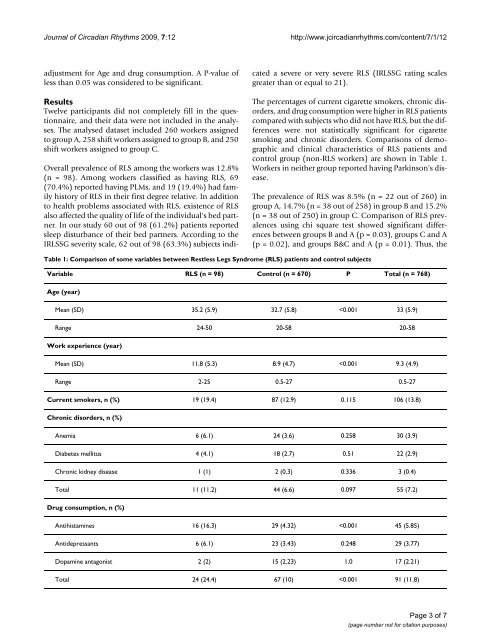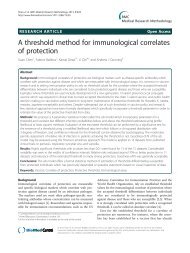Restless Legs Syndrome in shift workers - BioMed Central
Restless Legs Syndrome in shift workers - BioMed Central
Restless Legs Syndrome in shift workers - BioMed Central
You also want an ePaper? Increase the reach of your titles
YUMPU automatically turns print PDFs into web optimized ePapers that Google loves.
Journal of Circadian Rhythms 2009, 7:12 http://www.jcircadianrhythms.com/content/7/1/12<br />
adjustment for Age and drug consumption. A P-value of<br />
less than 0.05 was considered to be significant.<br />
Results<br />
Twelve participants did not completely fill <strong>in</strong> the questionnaire,<br />
and their data were not <strong>in</strong>cluded <strong>in</strong> the analyses.<br />
The analysed dataset <strong>in</strong>cluded 260 <strong>workers</strong> assigned<br />
to group A, 258 <strong>shift</strong> <strong>workers</strong> assigned to group B, and 250<br />
<strong>shift</strong> <strong>workers</strong> assigned to group C.<br />
Overall prevalence of RLS among the <strong>workers</strong> was 12.8%<br />
(n = 98). Among <strong>workers</strong> classified as hav<strong>in</strong>g RLS, 69<br />
(70.4%) reported hav<strong>in</strong>g PLMs, and 19 (19.4%) had family<br />
history of RLS <strong>in</strong> their first degree relative. In addition<br />
to health problems associated with RLS, existence of RLS<br />
also affected the quality of life of the <strong>in</strong>dividual's bed partner.<br />
In our study 60 out of 98 (61.2%) patients reported<br />
sleep disturbance of their bed partners. Accord<strong>in</strong>g to the<br />
IRLSSG severity scale, 62 out of 98 (63.3%) subjects <strong>in</strong>di-<br />
cated a severe or very severe RLS (IRLSSG rat<strong>in</strong>g scales<br />
greater than or equal to 21).<br />
The percentages of current cigarette smokers, chronic disorders,<br />
and drug consumption were higher <strong>in</strong> RLS patients<br />
compared with subjects who did not have RLS, but the differences<br />
were not statistically significant for cigarette<br />
smok<strong>in</strong>g and chronic disorders. Comparisons of demographic<br />
and cl<strong>in</strong>ical characteristics of RLS patients and<br />
control group (non-RLS <strong>workers</strong>) are shown <strong>in</strong> Table 1.<br />
Workers <strong>in</strong> neither group reported hav<strong>in</strong>g Park<strong>in</strong>son's disease.<br />
The prevalence of RLS was 8.5% (n = 22 out of 260) <strong>in</strong><br />
group A, 14.7% (n = 38 out of 258) <strong>in</strong> group B and 15.2%<br />
(n = 38 out of 250) <strong>in</strong> group C. Comparison of RLS prevalences<br />
us<strong>in</strong>g chi square test showed significant differences<br />
between groups B and A (p = 0.03), groups C and A<br />
(p = 0.02), and groups B&C and A (p = 0.01). Thus, the<br />
Table 1: Comparison of some variables between <strong>Restless</strong> <strong>Legs</strong> <strong>Syndrome</strong> (RLS) patients and control subjects<br />
Variable RLS (n = 98) Control (n = 670) P Total (n = 768)<br />
Age (year)<br />
Mean (SD) 35.2 (5.9) 32.7 (5.8)

















